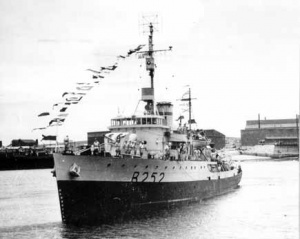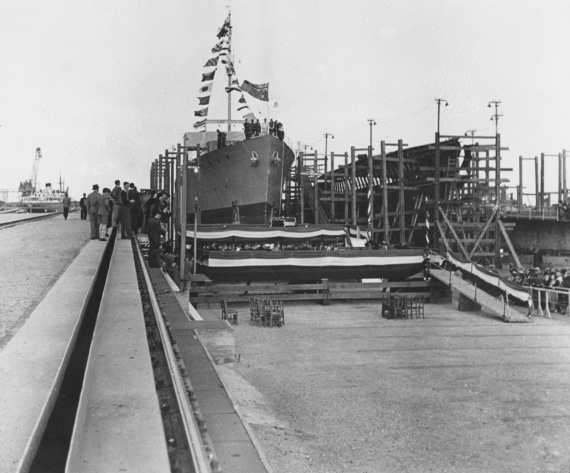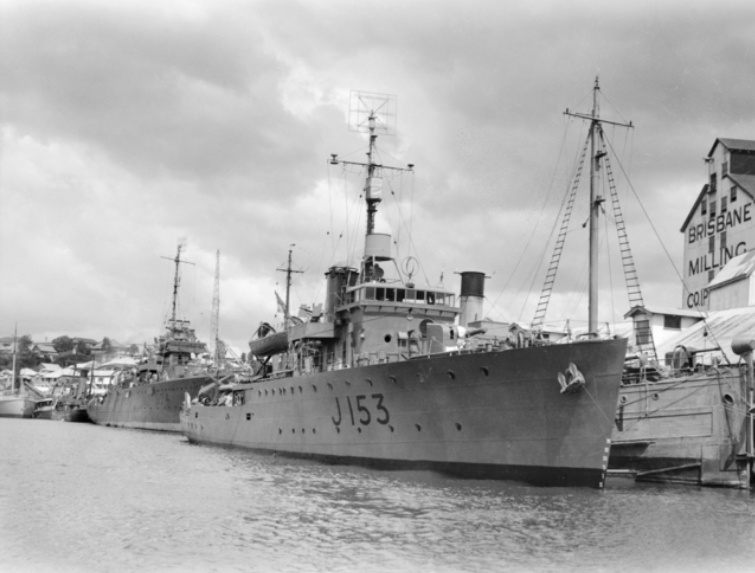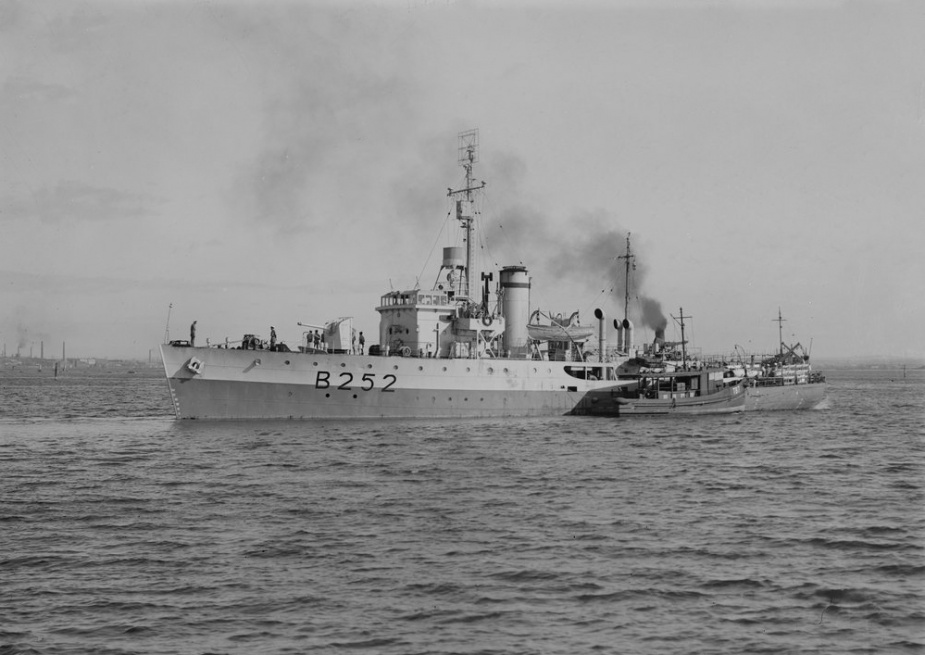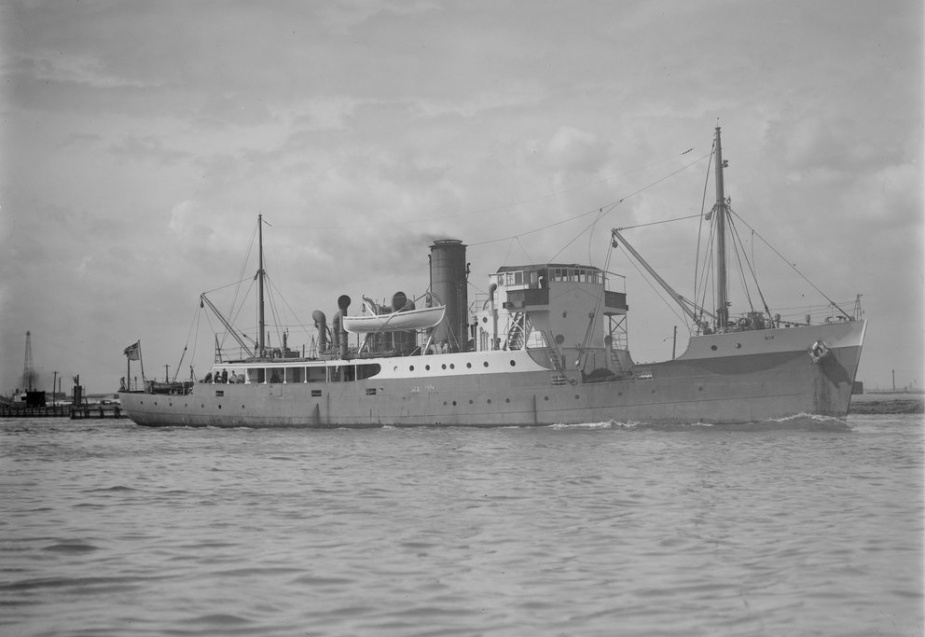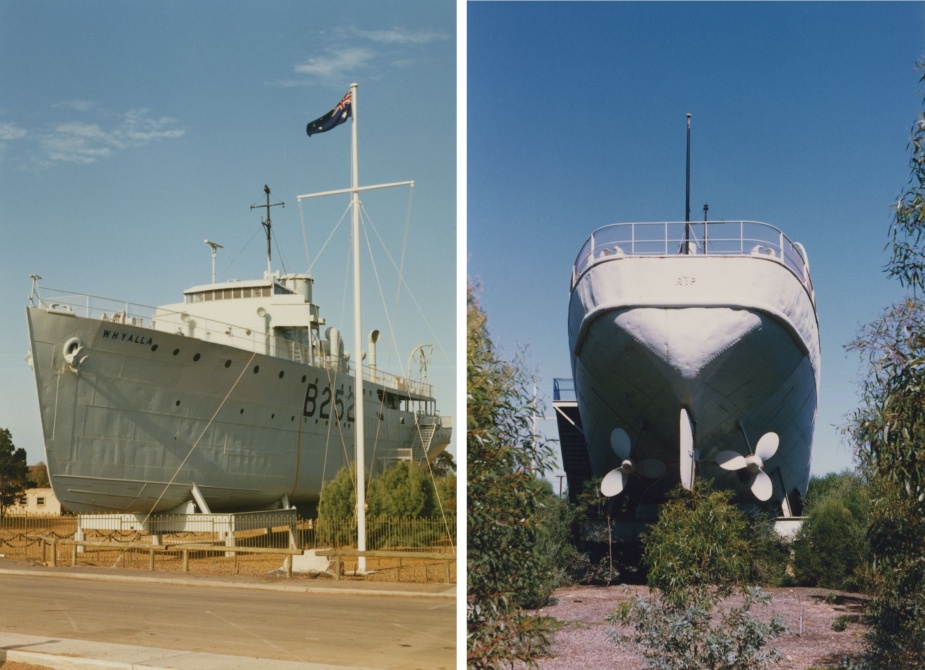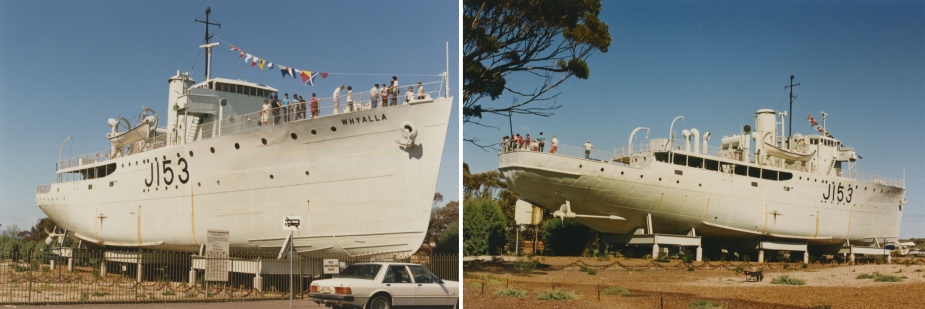HMAS Whyalla (I)
| Class |
Bathurst Class |
|---|---|
| Type |
Australian Minesweeper |
| Pennant |
J153 |
| Builder |
Broken Hill Pty Ltd, Whyalla, SA |
| Laid Down |
24 July 1940 |
| Launched |
12 May 1941 |
| Launched by |
Lady Barclay-Harvey, wife of the Governor of South Australia |
| Commissioned |
8 January 1942 |
| Decommissioned |
16 May 1946 |
| Dimensions & Displacement | |
| Displacement | 733 tons |
| Length | 186 feet |
| Beam | 31 feet |
| Draught | 8 feet 6 inches |
| Performance | |
| Speed | 15 knots |
| Complement | |
| Crew | 85 |
| Propulsion | |
| Machinery | Triple expansion, 2 shafts |
| Horsepower | 1750 |
| Armament | |
| Guns |
|
| Other Armament |
|
| Awards | |
| Battle Honours | |
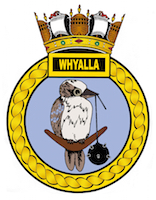
HMAS Whyalla (I) was one of sixty Australian Minesweepers (commonly known as corvettes) built during World War II in Australian shipyards as part of the Commonwealth Government's wartime shipbuilding programme. Twenty (including Whyalla (I)) were built on Admiralty order but manned and commissioned by the Royal Australian Navy. Thirty six were built for the Royal Australian Navy and four for the Royal Indian Navy.
Whyalla (I) commissioned at Whyalla on 8 January 1942 under the command of Lieutenant Leslie N Morison RANR(S).
Following commissioning and a work up period, Whyalla (I) went into service on escort and patrol duty on the Australian east coast. She was in Sydney Harbour on the night of 31 May/1 June 1942 when the Japanese midget submarine attack took place and was one of a number of ships allocated as escorts when Australian coastal convoys were instituted on 8 June 1942.
On 12 June 1942, with the United States destroyer USS Perkins, she was escorting a convoy of eight ships bound from Newcastle to Melbourne when the straggling Panamanian ship Guatemala was torpedoed and sunk. Whyalla (I) continued east coast coastal convoy escort duty until December 1942. No further losses were suffered by any of the convoys of which she was one of the escorting units.
In December 1942 Whyalla (I) proceeded to New Guinea where she took part in the operations leading to the capture of Buna at the end of the year. In 1943 she continued operations in the New Guinea theatre, operating as a survey ship. On 2 January 1943, in McLaren Harbour, Cape Nelson, New Guinea, Whyalla (I) and the small survey vessels HMA Ships Wareen (I) (Stella) and Polaris (I) were attacked by six dive bombers escorted by twelve fighters. All bombs missed their targets and except for minor damage from near misses and two sailors wounded by splinters, Whyalla (I) escaped unscathed.
Whyalla (I) continued the hazardous work of surveying the inadequately charted New Guinea waters until the end of April 1943, when she was relieved by HMAS Shepparton (I). She was at anchor in Milne Bay on 14 April when assembled shipping was attacked by forty to fifty bombers and about sixty fighters. Again the ship escaped serious damage but other vessels were not so fortunate. The Dutch merchant ship Van Heemskerk was a total loss. Whyalla (I) and her sister ships HMA Ships Kapunda (I) and Wagga (I) drew praise from the Naval Officer-in-Command ashore for their rescue and salvage work, remarking that “we were indeed fortunate to have the assistance of the three corvettes”.
In June 1943 Whyalla (I) returned to Australia for a major refit and was then reallocated for east coast convoy escort duty. She was engaged constantly on this service until February 1944, followed by a period on Sandy Cape anti-submarine patrol interspersed with escort duty, before further service in New Guinea waters from June 1944. In December 1944 she was attached to the British Pacific Fleet as a unit of the 21st Minesweeping Flotilla, consisting of nine Australian minesweepers.
In 1945 until the end of hostilities Whyalla (I) served on escort and anti-submarine patrol duty. During the period of March to May 1945 she escorted shipping between Manus and the Philippines before returning to Australia for refit in June. This period included participation in the operations for the capture of Okinawa (March to May).
The ship proceeded to Manus on 2 July 1945 for further escort service to the forward areas. In the immediate post war period the 21st Minesweeping Flotilla proceeded to Hong Kong. Whyalla (I), however, served only briefly in Chinese waters. In October she returned to Australia having steamed some 111,000 miles on war service.
Whyalla (I) paid off at Brisbane on 16 May 1946. On 10 February 1947 Whyalla (I) was sold to the Victorian Public Works Department. On 8 November 1947 the tug HMAS Reserve departed Brisbane for Melbourne with Whyalla (I) in tow. The vessels arrived at Melbourne on 14 November. Whyalla (I) was handed over to her new owner and renamed Rip, being employed as a lights maintenance vessel.
She ceased service as Rip in 1984. When the Whyalla City Council became aware that the ship was to sold as scrap, successful negotiations resulted in the Council purchasing her for $5000. She returned to Whyalla under her own power later in 1984.
Between February and April 1987, Whyalla (I) was slowly moved up the slipway from which she was launched in 1941, and then relocated two kilometres inland and placed on permanent foundations, becoming the centrepiece for the Whyalla Maritime Museum which was officially opened on 29 October 1988. Whyalla (I) is one of only two Bathurst Class preserved as museum ships, the other being HMAS Castlemaine in Williamstown, Victoria.
Note: This video is hosted on YouTube. Department of Defence users will not be able to view this video on the Defence Protected Network.
This cine film has been placed online as part of the Sea Power Centre - Australia’s ongoing archival digitisation program.
Further Reading
- The Corvettes: Forgotten Ships of the Royal Australian Navy, by Iris Nesdale - published by the Author, October, 1982.
- Notable Service to the Empire: Australian Corvettes and the British Pacific Fleet 1944-45, by Hugh Campbell - published by Naval Historical Society of Australia, Inc. 1995
- Corvettes - Little Ships for Big Men, by Frank B Walker - published by Kingfisher Press, NSW, 1996.
- The Australian Centenary History of Defence Volume III, The Royal Australian Navy, edited by David Stevens, Oxford University Press, South Melbourne, Victoria, Australia, 2001.

